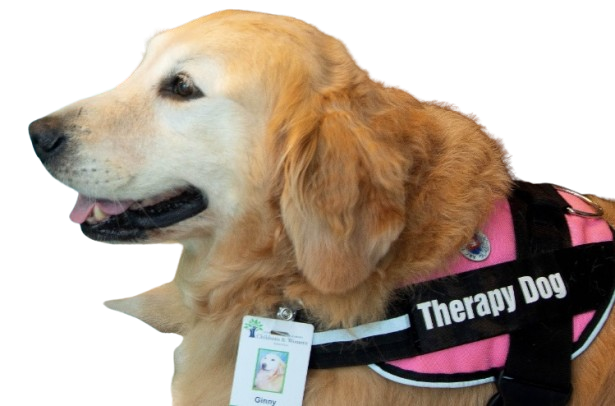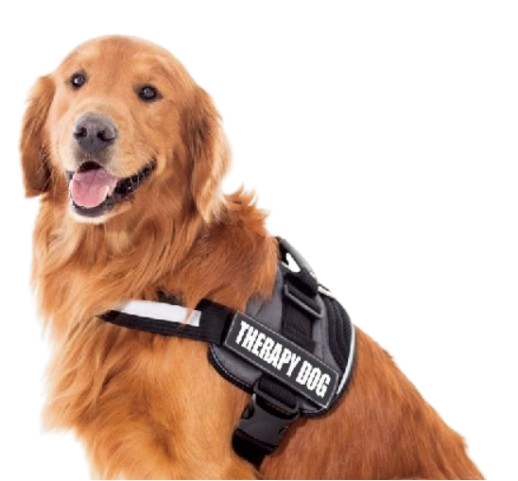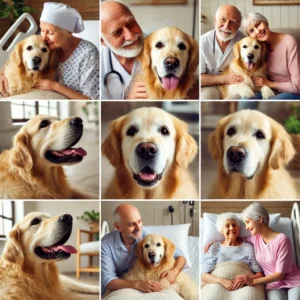
Understanding Their Roles and Unique Contributions
Testimonials | Share Your Story and Inspire Others

The bond between humans and dogs has evolved into remarkable partnerships that significantly impact lives. Among these partnerships, service dogs, therapy dogs, and emotional support animals (ESAs) play distinct yet equally important roles. While often used interchangeably, these terms refer to different types of trained or designated dogs, each with its purpose and responsibilities. This post explores the differences and intersections between therapy dogs, service dogs, and ESAs, shedding light on their unique contributions to human well-being.
Therapy dogs hold a special place in the hearts of many, offering emotional support, comfort, and companionship to individuals and communities in need. Unlike service dogs, whose roles focus on assisting individuals with specific disabilities, therapy dogs are known for connecting emotionally with a wide audience, spreading joy and reducing stress in various settings. In Fairfax, VA, therapy dogs have become integral to fostering community well-being. Let’s explore their history, training, and the unique ways they contribute to life in Fairfax and beyond.

The History of Therapy Dogs
The concept of therapy dogs dates back to World War II, when a soldier named Corporal William Wynne adopted a Yorkshire Terrier named Smoky. Smoky’s visits to wounded soldiers in hospitals revealed the profound therapeutic benefits of canine companionship. This inspired further exploration into the use of dogs for emotional and psychological healing.
In Fairfax, VA, the history of therapy dogs aligns with a growing national movement to incorporate animal-assisted interventions in healthcare, education, and community outreach programs. Organizations and local groups in Fairfax have championed the integration of therapy dogs into hospitals, schools, and nursing homes, fostering a legacy of healing and support.

Training Requirements for Therapy Dogs
Therapy dogs must exhibit exceptional temperament and adaptability to excel in their roles. While they do not require the same specialized training as service dogs, therapy dogs must pass certain evaluations to ensure they are well-suited for public interactions. Training typically focuses on:


- Socialization: Therapy dogs are exposed to various environments, people, and other animals to ensure they remain calm and friendly in diverse settings.
- Basic Obedience: Commands such as sit, stay, come, and heel are essential to maintain control during visits.
- Certifications: Many therapy dogs in Fairfax undergo certification programs through organizations like Therapy Dogs International (TDI) or the Alliance of Therapy Dogs. These programs assess the dog’s behavior and readiness for therapy work.
- Health and Hygiene: Therapy dogs must meet stringent health requirements, including vaccinations and grooming standards, to ensure they pose no risk to the individuals they visit.
Impact of Therapy Dogs in Fairfax, VA
Therapy dogs have touched countless lives in Fairfax, offering comfort in hospitals, stress relief during exams at local schools, and companionship in senior living facilities. Their presence has proven to:
- Reduce Stress and Anxiety: Therapy dogs help lower cortisol levels, contributing to a sense of calm and relaxation.
- Enhance Social Engagement: Interactions with therapy dogs encourage communication and bonding, especially in group settings.
- Promote Healing: Research indicates that therapy dogs can accelerate physical recovery and improve emotional resilience.
Fairfax local organizations have embraced therapy dogs as ambassadors of joy and healing. For example, Inova Fairfax Hospital has a therapy dog department, and therapy dog teams frequently participate in reading programs at Fairfax County Public Libraries, where children improve their literacy skills by reading aloud to attentive, nonjudgmental canine listeners.
How You Can Support Therapy Dog Programs

Fairfax residents can get involved by:
- Volunteering: Join Canine Concierge as a handler or supporter.
- Advocating: Promote the inclusion of therapy dogs in nursing homes, senior centers, hospitals, and community events.
- Donating: Contributions to Canine Concierge therapy dog programs help cover training, certification, and operational costs.
Therapy dogs are more than companions; they are bridges to emotional and psychological well-being. In Fairfax, VA, their impact continues to grow, touching lives and strengthening the community one wagging tail at a time.

What Are Service Dogs?
Service dogs are highly trained animals that perform specific tasks to assist individuals with disabilities. Their roles are legally protected under the Americans with Disabilities Act (ADA), which grants them access to public spaces to aid their handlers. These tasks often address mobility, medical, sensory, or psychiatric needs. Examples include guiding visually impaired individuals, alerting those with hearing impairments, or providing stability to those with mobility challenges.
Service dogs undergo rigorous training to perform their tasks reliably in various environments. These dogs are not considered pets but essential working partners who help their handlers achieve greater independence and safety. Their training often spans 12 to 24 months, focusing on skills tailored to the handler’s specific needs.
What Are Emotional Support Animals (ESAs)?
Emotional support animals, commonly referred to as ESAs, provide comfort and companionship to individuals experiencing emotional or psychological challenges. Unlike service dogs and therapy dogs, ESAs do not require specialized training to perform specific tasks or behaviors. Instead, their mere presence is therapeutic for their owners.
ESAs are often prescribed by mental health professionals and can help individuals with conditions such as anxiety, depression, or PTSD. However, they are not granted the same legal protections as service dogs. While the Fair Housing Act allows ESAs to live with their owners in housing that might otherwise prohibit pets, they do not have public access rights under the ADA.



Key Differences Between Service Dogs, Therapy Dogs, and ESAs
- Purpose: Service dogs perform specific tasks for individuals with disabilities, therapy dogs provide emotional and psychological comfort to groups or individuals, and ESAs offer companionship to their owners.
- Training: Service dogs undergo extensive, specialized training; therapy dogs are trained for general social interactions; ESAs do not require formal training.
- Legal Protections: Service dogs are protected under the ADA, therapy dogs have limited permissions, and ESAs are primarily covered by housing laws.
- Handlers: Service dogs work with one handler for continuous support, therapy dogs interact with many people, and ESAs exclusively support their owners.
How Do These Roles Intersect?
Despite their differences, service dogs, therapy dogs, and ESAs share the ability to profoundly impact human lives. Service dogs, while task-oriented, often provide emotional support to their handlers, blurring the lines between their functional and therapeutic roles. Similarly, therapy dogs and ESAs can introduce individuals to the benefits of structured animal-assisted interventions, like animal-assisted therapy (AAT), fostering a deeper appreciation for the healing power of animals.
Raising Awareness and Understanding
Incorporating discussions of therapy dogs and ESAs into the broader conversation about service dogs can help raise awareness about the spectrum of animal-assisted support. Many individuals searching for “service dogs” may benefit from learning about therapy dogs or ESAs as alternatives that better suit their needs. By understanding these differences and connections, the public can make informed decisions about the support they need and advocate for programs that enhance human and animal well-being.
Whether through the task-specific assistance of service dogs, the comforting presence of therapy dogs, or the companionship of ESAs, these animals showcase the incredible impact of canine-human connections. Exploring their roles not only enriches our understanding but also fosters appreciation for the unique bond between humans and dogs.

Passenger blasted for bringing ‘emotional support’ Great Dane on airplane
* video addendum: Plane Passenger Brings His Great Dane Service Dog on Flight








Leave a Reply